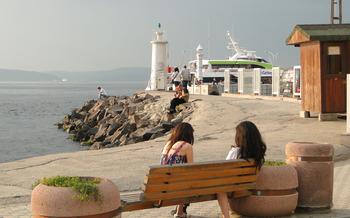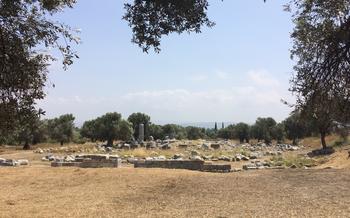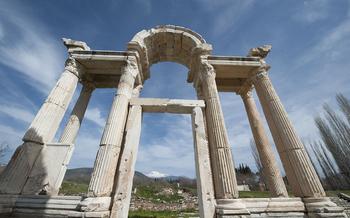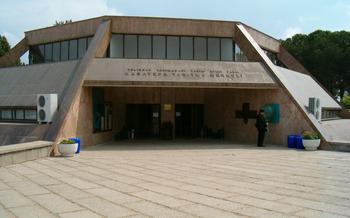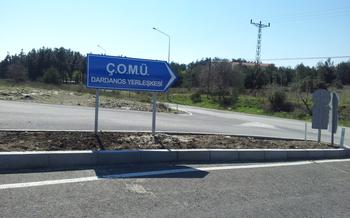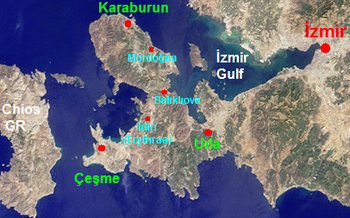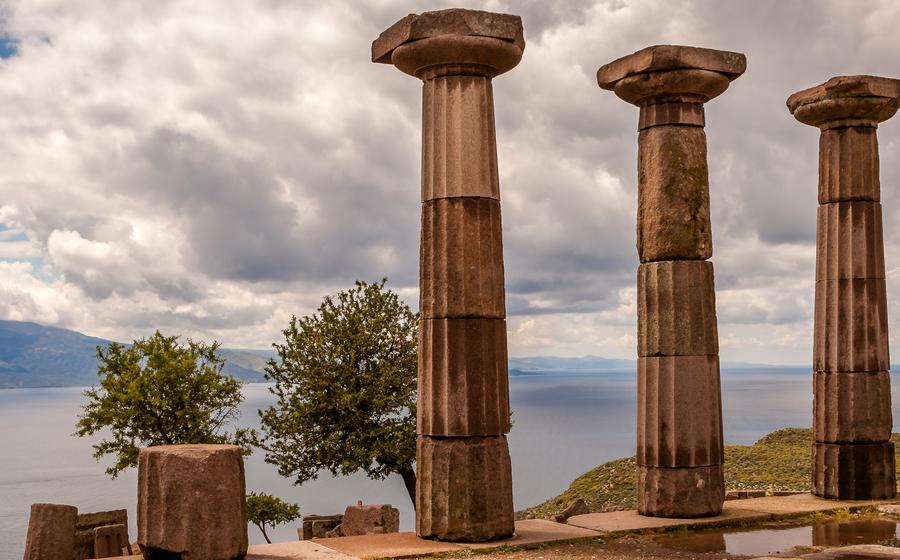
Assos Temple of Athena
- The Antiquity of Assos Temple of Athena
- The Temple's Purpose and Significance
- The Temple's Excavation and Restoration
- The Archaeological Site of Assos
- The Temple's Panoramic Views
- The Temple's Cultural Legacy
- Visiting the Assos Temple of Athena
- Exploring the Town of Assos
- Accommodation and Dining Options
- Accommodation
- Dining
- Tips for History and Archaeology Enthusiasts
- Safety and Precautions
- Insider Tip: Hidden Gems Nearby
The Antiquity of Assos Temple of Athena
The Assos Temple of Athena, also known as the Athena Temple, stands as a testament to the rich history and architectural prowess of ancient Greece. Its origins date back to the 6th century BC, making it one of the oldest and most significant temples in Turkey. The temple's construction marked a pivotal moment in the development of Greek architecture, showcasing the transition from the Archaic to the Classical style. Located atop a hill overlooking the Aegean Sea, the temple's strategic position allowed for both religious ceremonies and defense against potential invaders, highlighting its dual significance as a sacred and protective structure.
The Temple's Purpose and Significance
The Assos Temple of Athena served various purposes throughout its existence, reflecting the cultural and religious life of the ancient city.
-
Religious Ceremonies: The primary function of the temple was to serve as a sacred space for religious ceremonies and rituals dedicated to the goddess Athena, the patron deity of the city. Worshippers would make offerings, pray, and participate in religious festivals held within the temple's sacred precincts.
-
Political Gatherings: The temple also played a significant role in the political life of Assos. Important civic and political matters were discussed and decided within its walls. Assemblies and meetings of the city's leaders and citizens took place in the temple, reflecting its dual role as a religious and civic center.
-
Cultural Events: In addition to its religious and political functions, the temple served as a venue for cultural events and performances. Theatrical productions, musical concerts, and poetry recitals were held within the temple grounds, providing entertainment and cultural enrichment for the inhabitants of Assos.
The Temple's Excavation and Restoration
After centuries of neglect and obscurity, the Assos Temple of Athena was finally rediscovered in the 19th century by European explorers. The first excavation efforts were conducted in the 1880s by a team of British archaeologists led by Francis Calvert. Calvert and his team uncovered the temple's ruins and made significant progress in understanding its history and significance.
In the early 20th century, excavations were continued by American archaeologist Joseph Thacher Clarke. Clarke's work revealed the temple's impressive architectural details and shed light on its construction and design. He also documented the temple's inscriptions and other artifacts, which provided valuable information about its religious and cultural significance.
The restoration of the Assos Temple of Athena has been an ongoing process throughout the 20th and 21st centuries. The Turkish government has played a major role in preserving and restoring the site, conducting extensive archaeological excavations and implementing restoration projects. These efforts have involved the conservation of the temple's stonework, the reconstruction of its missing columns, and the stabilization of its foundations.
One of the greatest challenges in the restoration of the Assos Temple of Athena has been the need to balance preservation with accessibility. The temple's ruins are located on a steep hillside, making it difficult for visitors to access the site. In recent years, however, significant progress has been made in improving accessibility, including the construction of new pathways and viewing platforms.
The Archaeological Site of Assos
The Assos Temple of Athena is situated within the larger archaeological site of Assos, which offers a glimpse into the region's rich ancient history. In addition to the temple, the site encompasses the ruins of a Hellenistic city, including a well-preserved theater, an odeon, a gymnasium, and a necropolis. These structures provide valuable insights into the daily lives, cultural practices, and urban planning of the ancient Greeks.
The archaeological site of Assos has been the subject of extensive excavations since the late 1800s, uncovering a wealth of artifacts and shedding light on the city's historical significance. The ongoing excavations continue to reveal new discoveries that help to piece together the puzzle of Assos' past. Visitors can explore the site independently or join guided tours that provide detailed explanations and insights into the ancient ruins.
The historical context of Assos is particularly fascinating. The city was founded in the 7th century BC by Aeolian colonists from Lesbos and quickly became an important trading hub and naval base. It reached its peak during the Hellenistic period, when it came under the rule of Alexander the Great and his successors. Assos was later conquered by the Romans and remained part of the Roman Empire until the 4th century AD.
Exploring the archaeological site of Assos is a journey through time, where visitors can immerse themselves in the grandeur of ancient Greek architecture, discover the secrets of a bygone era, and gain a deeper appreciation for the rich cultural heritage of Turkey.
The Temple's Panoramic Views
The Assos Temple of Athena stands atop a hill that offers breathtaking views of the surrounding landscape. From the temple's elevated position, visitors can feast their eyes on a panorama that stretches for miles in every direction. To the north, the azure waters of the Aegean Sea sparkle in the sunlight, dotted with small islands and fishing boats. To the south, the lush green hills of the Kazdağları (Mount Ida) rise majestically, their peaks often capped with snow. On clear days, it is even possible to see the distant silhouette of Lesvos, a Greek island that lies just across the sea.
The temple's panoramic views are not only beautiful but also historically significant. In ancient times, these views would have served as a strategic advantage, allowing the temple's inhabitants to keep watch for approaching enemies or ships. Today, they offer visitors a chance to step back in time and imagine what life was like in this ancient city.
For the best photographic opportunities, visit the temple early in the morning or late in the afternoon, when the light is soft and golden. The temple is also a popular spot for nature walks and hiking trails, which offer visitors the chance to explore the surrounding countryside and enjoy the stunning views from different perspectives.
The Temple's Cultural Legacy
The Assos Temple of Athena stands as a testament to the enduring power of ancient Greek architecture and culture. Its design and construction techniques influenced later architectural styles, both in Greece and beyond. The temple's iconic columns, pediments, and friezes became defining features of classical architecture, inspiring countless buildings throughout the ancient world and beyond.
Beyond its architectural legacy, the Assos Temple of Athena holds cultural and mythological significance. It was dedicated to the Greek goddess Athena, who was revered as the patron deity of wisdom, war, and crafts. The temple served as a place of worship and religious ceremonies, where ancient Greeks sought guidance and protection from Athena.
Over the centuries, the temple's ruins have become a source of inspiration for artists, writers, and historians. Its majestic presence has captured the imagination of countless visitors, evoking a sense of awe and wonder. The temple's weathered stones and intricate carvings have been immortalized in paintings, photographs, and literary works, ensuring its legacy lives on for generations to come.
Visiting the Assos Temple of Athena
The Assos Temple of Athena welcomes visitors from around the world. Its opening hours typically extend from morning until evening, allowing ample time to explore the site. There is a modest admission fee that contributes to the temple's upkeep and conservation efforts.
For a deeper understanding of the temple's history and significance, guided tours are available. Led by knowledgeable experts, these tours provide insights into the temple's construction, purpose, and cultural legacy. Alternatively, visitors can opt for self-exploration, taking their time to wander through the ancient ruins and absorb the atmosphere of this historical site.
The temple's accessibility for visitors with disabilities is a testament to its inclusivity. Ramps and designated pathways ensure that everyone can enjoy the temple's wonders, regardless of their physical abilities.
Exploring the Town of Assos
Beyond the ancient temple, the town of Assos itself is a treasure trove of history and culture. As you wander through its quaint streets and alleys, you'll be transported back in time, surrounded by traditional Ottoman-era houses, charming cafes, and local shops showcasing handmade crafts and souvenirs.
Historical Landmarks and Monuments
Assos is dotted with historical landmarks that tell the story of its rich past. Visit the Assos Castle, perched atop a hill, offering panoramic views of the town and the Aegean Sea. Explore the ruins of the ancient Agora, where merchants and citizens once gathered for trade and political discussions. Don't miss the Assos Museum, which houses a collection of artifacts discovered during excavations, providing insights into the town's ancient heritage.
Local Shops and Restaurants
Assos is a haven for those who appreciate local flavors and craftsmanship. Browse the colorful shops selling handmade carpets, pottery, jewelry, and other unique souvenirs. Indulge in traditional Turkish cuisine at the local restaurants, where you can savor fresh seafood, succulent kebabs, and delectable meze platters.
Insider Tip: Sunset at the Harbor
For a truly magical experience, head to the harbor at sunset. As the sky transforms into a canvas of vibrant hues, watch the fishing boats return to shore, casting a picturesque silhouette against the backdrop of the ancient temple. Capture this breathtaking moment with your camera and soak in the tranquility of this enchanting seaside town.
Accommodation and Dining Options
Accommodation
Assos offers a range of accommodation options to suit different budgets and preferences. From charming guesthouses and boutique hotels to modern resorts, there's something for every traveler. For those seeking a truly immersive experience, consider staying in a traditional Turkish house, many of which have been lovingly restored and offer a glimpse into the town's rich history.
Dining
Assos is a culinary paradise, with a diverse selection of restaurants catering to every taste. From traditional Turkish cuisine to international delights, there's something to satisfy every palate. Be sure to sample the local specialties, such as freshly caught seafood, grilled meats, and delicious mezze platters. For a truly memorable dining experience, head to one of the waterfront restaurants and enjoy your meal with stunning views of the Aegean Sea.
Tips for History and Archaeology Enthusiasts
Embrace the wealth of knowledge available on the Assos Temple of Athena and its surrounding area. Delve into books like "Assos: A Guide to the Site and Its History" by Fikret Yegül or "The Temple of Athena at Assos" by John McCredie for in-depth information and historical context.
Plan a trip that incorporates other significant archaeological sites in Turkey. Explore the ancient city of Ephesus, marvel at the well-preserved ruins of Hierapolis, or venture to the underground city of Derinkuyu, each offering unique insights into Turkey's rich past.
Engage with local historians, archaeologists, and tour guides. Their knowledge and expertise can enhance your understanding of the temple and its significance, providing a deeper appreciation for this ancient wonder.
Safety and Precautions
When visiting the Assos Temple of Athena, it is essential to prioritize safety and take necessary precautions:
-
Weather Conditions and Sun Protection: Assos experiences warm and sunny weather for most of the year. Visitors should wear sunscreen, carry hats, and stay hydrated to avoid heatstroke and sunburn.
-
Terrain and Uneven Surfaces: The archaeological site features uneven surfaces, rocky paths, and steps. Proper footwear with good traction is recommended to prevent slips and falls.
-
Respecting the Archaeological Site: Visitors should be mindful of their behavior and actions within the archaeological site. It is important to refrain from touching or climbing on ancient structures, as this can damage or disturb them.
Insider Tip: Hidden Gems Nearby
Beyond the temple itself, Assos is a treasure trove of hidden gems waiting to be explored. For those seeking a deeper dive into ancient history, the nearby archaeological site of Behramkale offers a glimpse into the Hellenistic period with its well-preserved city walls, agora, and theater. Nature enthusiasts will delight in the scenic Assos-Behramkale Nature Park, with its lush forests, cascading waterfalls, and panoramic views.
Venture further afield to discover the picturesque village of Kadırga, nestled along the Aegean coast. With its charming stone houses, colorful fishing boats, and tranquil atmosphere, Kadırga offers a taste of authentic Turkish village life. Indulge in freshly caught seafood at one of the local restaurants, soak up the sun on the pristine beaches, or embark on a boat tour to explore hidden coves and secluded islands.
For a unique cultural experience, head to the nearby village of Yeşilyurt, renowned for its traditional pottery and handicrafts. Watch skilled artisans at work, learn about the ancient techniques passed down through generations, and bring home a handmade souvenir as a cherished reminder of your journey.

